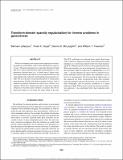| dc.contributor.author | Jarapour, Behnam | |
| dc.contributor.author | Goyal, Vivek K. | |
| dc.contributor.author | McLaughlin, Dennis | |
| dc.contributor.author | Freeman, William T. | |
| dc.date.accessioned | 2012-01-03T19:40:43Z | |
| dc.date.available | 2012-01-03T19:40:43Z | |
| dc.date.issued | 2009-09 | |
| dc.date.submitted | 2009-02 | |
| dc.identifier.issn | 0016-8033 | |
| dc.identifier.issn | 1942-2156 | |
| dc.identifier.uri | http://hdl.handle.net/1721.1/67893 | |
| dc.description.abstract | We have developed a new regularization approach for estimating unknown spatial fields, such as facies distributions or porosity maps. The proposed approach is especially efficient for fields that have a sparse representation when transformed into a complementary function space (e.g., a Fourier space). Sparse transform representations provide an accurate characterization of the original field with a relatively small number of transformed variables. We use a discrete cosine transform (DCT) to obtain sparse representations of fields with distinct geologic features, such as channels or geologic formations in vertical cross section. Low-frequency DCT basis elements provide an effectively reduced subspace in which the sparse solution is searched. The low-dimensional subspace is not fixed, but rather adapts to the data.The DCT coefficients are estimated from spatial observations with a variant of compressed sensing. The estimation procedure minimizes an l2-norm measurement misfit term while maintaining DCT coefficient sparsity with an l1-norm regularization term. When measurements are noise-dominated, the performance of this procedure might be improved by implementing it in two steps — one that identifies the sparse subset of important transform coefficients and one that adjusts the coefficients to give a best fit to measurements. We have proved the effectiveness of this approach for facies reconstruction from both scattered- point measurements and areal observations, for crosswell traveltime tomography, and for porosity estimation in a typical multiunit oil field. Where we have tested our sparsity regulariza-tion approach, it has performed better than traditional alter-natives. | en_US |
| dc.language.iso | en_US | |
| dc.publisher | Society of Exploration Geophysicists | en_US |
| dc.relation.isversionof | http://dx.doi.org/10.1190/1.3157250 | en_US |
| dc.rights | Article is made available in accordance with the publisher's policy and may be subject to US copyright law. Please refer to the publisher's site for terms of use. | en_US |
| dc.source | MIT web domain | en_US |
| dc.title | Transform-domain sparsity regularization for inverse problems in geosciences | en_US |
| dc.type | Article | en_US |
| dc.identifier.citation | Jafarpour, Behnam et al. “Transform-domain sparsity regularization for inverse problems in geosciences.” Geophysics 74.5 (2009): R69. ©2009 Society of Exploration Geophysicists. | en_US |
| dc.contributor.department | Massachusetts Institute of Technology. Department of Civil and Environmental Engineering | en_US |
| dc.contributor.department | Massachusetts Institute of Technology. Department of Electrical Engineering and Computer Science | en_US |
| dc.contributor.approver | Goyal, Vivek K. | |
| dc.contributor.mitauthor | Goyal, Vivek K. | |
| dc.contributor.mitauthor | Freeman, William T. | |
| dc.contributor.mitauthor | McLaughlin, Dennis | |
| dc.relation.journal | Geophysics | en_US |
| dc.eprint.version | Final published version | en_US |
| dc.type.uri | http://purl.org/eprint/type/JournalArticle | en_US |
| eprint.status | http://purl.org/eprint/status/PeerReviewed | en_US |
| dspace.orderedauthors | Jafarpour, Behnam; Goyal, Vivek K.; McLaughlin, Dennis B.; Freeman, William T. | en |
| dc.identifier.orcid | https://orcid.org/0000-0002-2231-7995 | |
| mit.license | PUBLISHER_POLICY | en_US |
| mit.metadata.status | Complete | |
